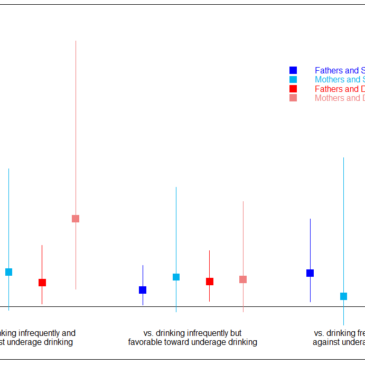In a 1980s anti-drug PSA, a father confronts his teenage son about a box of drug paraphernalia found in the boy’s closet. The father asks, “Who taught you how to do this stuff?” The boy’s response is the big reveal. “You, all right? I learned it by watching you!” The last line comes from an off-camera narrator: “Parents who use drugs have children who use drugs.” Indeed, for many kinds of activities, parents who are involved tend to have children who are involved (e.g., sports: Shakib, 2004, smoking: Green et al., 1991). In this week’s DRAM, to open our Special Series on Fatherhood and Addiction, we summarize a recent study that explored how mothers’ and fathers’ drinking habits and attitudes shape their children’s drinking behavior (Hung et al., 2015).
Methods
- Nearly 4,000 9th grade students, roughly half boys and half girls, completed surveys between 2006 and 2009 as part of the the Child and Adolescent Behaviors in Long-term Evolution project in Taiwan (Yen, 2002).
- Measures used in the current study included:
- Students’ past month use of alcohol
- Students’ perceptions of their parents’ drinking frequency, later collapsed into “used infrequently” (no more than once or twice a month) versus “used frequently” (more than once or twice a month)
- Students’ perceptions of their parents’ attitudes about underage drinking (“unfavorable” versus “favorable”).
- The researchers used these data to categorize each parent as
- drinking infrequently and against underage drinking (2214 fathers, 2703 mothers)
- drinking infrequently but favorable toward underage drinking (1172 fathers, 1179 mothers)
- drinking frequently but against underage drinking (301 fathers, 39 mothers), or
- drinking frequently and favorable towards underage drinking (285 fathers, 51 mothers).
- The researchers ran logistic regressions, separately for boys and girls and moms and dads, studying whether students whose parents drank frequently and were favorable toward underage drinking were at higher risk for past-month drinking than other students.
Results
- Figure 1 shows the pattern of results.
- Boys:
- Boys with fathers who drank frequently and were favorable towards underage drinking were at higher risk than all other groups for using alcohol in the last month.
- However, boys’ likelihood of past month drinking did not differ according to their mothers’ drinking frequencies or attitudes.
- Girls:
- Girls with fathers who drank frequently and were favorable toward underage drinking were at higher risk for past-month drinking than those whose fathers drank infrequently.
- Girls with mothers who drank frequently and were favorable toward underage drinking had higher risk for past-month drinking than girls whose mothers drank infrequently and were against underage drinking.
Figure 1: Odds ratios (boxes) and 95% confidence intervals (lines) for students whose parents who drank frequently and had favorable attitudes towards underage drinking versus students whose parents were in other groups. Odds ratios above 1 indicate higher risk for past-month drinking compared with other students. Adapted from Hung et al. (2015). Click to enlarge.
Limitations
- The data were collected in Taiwan between 2006 and 2009. The results may not be generalizable to similarly-aged children today, either in Taiwan or on other parts of the world. For example, cultural expectations of the parent/child relationship and its influences might be different in other parts of Asia, in Europe, or in the U.S.
- The study only considered drinking as a binary variable, and only over the previous month. The study did not take into account the frequency of alcohol use within that month, in terms of either days of alcohol use per week or number of drinks per drinking session.
Conclusion
The musical (and movie) Into the Woods ends with the warning, “Careful the things you say. Children will listen. Careful the things you do. Children will see and learn.” There seems to be some wisdom in these words: in this study, children were at higher risk for drinking if their parents—especially their dads—drank frequently and endorsed underage drinking. Mothers’ drinking habits and attitudes seemed to have much less of an effect on their children’s drinking, especially sons. Among all children whose fathers were favorable toward underage drinking, those whose fathers drank infrequently tended to be at lower risk for underage drinking. Parents’ actions spoke louder than their words. It would be interesting to replicate this study in other countries, to see if the differences in fathers’ and mothers’ influences are Taiwanese-culture specific or more universal, and to see if actions still count more than words.
– Matthew Tom
What do you think? Please use the comment link below to provide feedback on this article.
References
Green, G., Macintyre, S., West, P., & Ecob, R. (1991). Like parent like child? Associations between drinking and smoking behaviour of parents and their children. Addiction, 86(6), 745–758.
Hung, C.-C., Chang, H.-Y., Luh, D.-L., Wu, C.-C., & Yen, L.-L. (2015). Do parents play different roles in drinking behaviours of male and female adolescents? A longitudinal follow-up study. BMJ Open, 5(4), e007179–e007179.
Shakib, S. (2004). How High School Athletes Talk about Maternal and Paternal Sporting Experiences: Identifying Modifiable Social Processes for Gender Equity Physical Activity Interventions. International Review for the Sociology of Sport, 39(3), 275–299.
Yen, L.-L. (2002). Child and adolescent behaviour in long-term evolution (CABLE): a school-based health lifestyle study. Promotion & Education, 9(1 suppl), 33–40.





